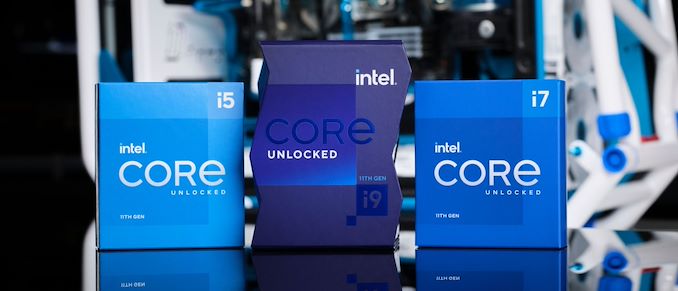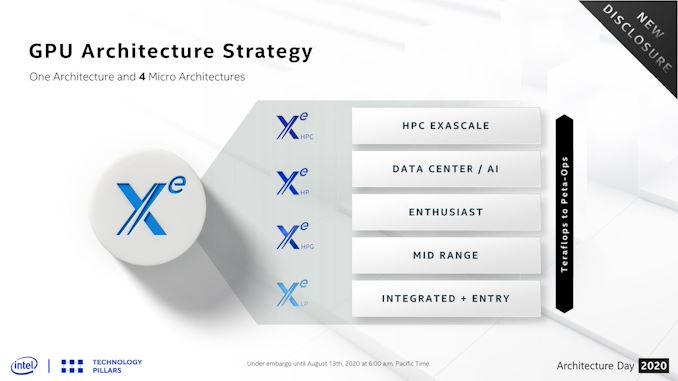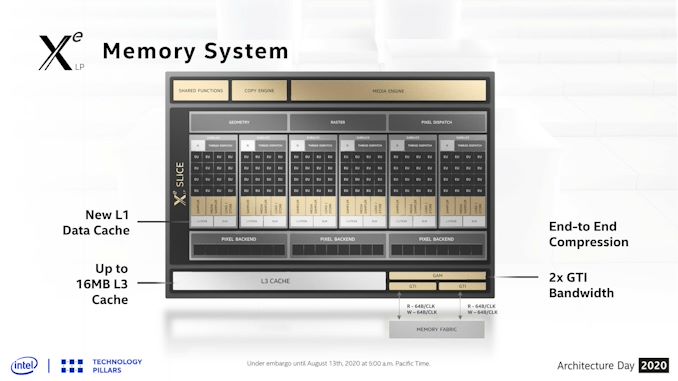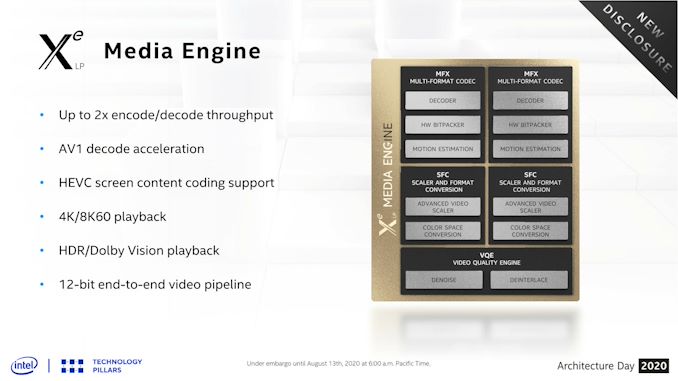Intel’s Integrated Graphics Mini-Review: Is Rocket Lake Core 11th Gen Competitive?
by Dr. Ian Cutress on May 7, 2021 10:20 AM EST
In the last few months we have tested the latest x86 integrated graphics options on the desktop from AMD, with some surprising results about how performant a platform with integrated graphics can be. In this review, we’re doing a similar test but with Intel’s latest Rocket Lake Core 11th Gen processors. These processors feature Intel’s Xe-LP graphics, which were touted as ‘next-generation’ when they launched with Intel’s mobile-focused Tiger Lake platform. However, the version implemented on Rocket Lake has fewer graphics units, slower memory, but a nice healthy power budget to maximize. Lo, Intel set forth for battle.
When a CPU meets GPU
Intel initially started integrating graphics onto its systems in 1999, by pairing the chipset with some form of video output. In 2010, the company moved from chipset graphics to on-board processor graphics, enabling the graphics hardware to take advantage of a much faster bandwidth to main memory as well as a much lower latency. Intel’s consumer processors now feature integrated graphics as the default configuration, with Intel at times dedicating more of the processor design to graphics than to actual cores.
| Intel CPUs: IGP as a % of Die Area | ||||||
| AnandTech | Example | Launched | Cores | IGP | Size | IGP as Die Area % |
| Sandy Bridge | i7-2600K | Jan 2011 | 4 | Gen6 | GT2 | 11% |
| Ivy Bridge | i7-3770K | April 2012 | 4 | Gen7 | GT2 | 29% |
| Haswell | i7-4770K | June 2013 | 4 | Gen7.5 | GT2 | 29% |
| Broadwell | i7-5775C | June 2015 | 4 | Gen8 | GT3e | 48% |
| Skylake | i7-6700K | Aug 2015 | 4 | Gen9 | GT2 | 36% |
| Kaby Lake | i7-7700K | Jan 2017 | 4 | Gen9 | GT2 | 36% |
| Coffee Lake | i7-8700K | Sept 2017 | 6 | Gen9 | GT2 | 30% |
| Coffee Lake | i9-9900K | Oct 2018 | 8 | Gen9 | GT2 | 26% |
| Comet Lake | i9-10900K | April 2020 | 10 | Gen9 | 24 EUs | 22% |
| Rocket Lake | i9-11900K | March 2021 | 8 | Xe-LP | 32 EUs | 21% |
| Mobile CPUs | ||||||
| Ice Lake-U | i7-1065G7 | Aug 2019 | 4 | Gen11 | 64 EUs | 36% |
| Tiger Lake-U | i7-1185G7 | Sept 2020 | 4 | Xe-LP | 96 EUs | 32% |
All the way from Intel’s first integrated graphics to its 2020 product line, Intel was reliant on its ‘Gen’ design. We saw a number of iterations over the years, with updates to the function and processing ratios, with Gen11 featuring heavily in Intel’s first production 10nm processor, Ice Lake.
The latest graphics design however is different. No longer called ‘Gen’, Intel upcycled its design with additional compute, more features, and an extended effort for the design to scale from mobile compute all the way up to supercomputers. This new graphics family, known as Xe, is now the foundation of Intel’s graphics portfolio. It comes in four main flavors:
- Xe-HPC for High Performance Computing in Supercomputers
- Xe-HP for High Performance and Optimized FP64
- Xe-HPG for High Performance Gaming with Ray Tracing
- Xe-LP for Low Power for Integrated and Entry Level
Intel has initially rolled out its LP designs into the market place, first with its Tiger Lake mobile processors, then with its Xe MAX entry level notebook graphics card, and now with Rocket Lake.
Xe-LP, A Quick Refresher
Intel’s LP improves on the previous Gen11 graphics by reorganizing the base structure of the design. Rather than 7 logic units per execution unit, we now have 8, and LP’s front-end can dispatch up two triangles per clock rather than one. The default design of LP involves 96 execution units, split into a centralized ‘slice’ that has all the geometry features and fixed function hardware, and up to 6 ‘sub-slices’ each with 16 logic units and 64 KiB of L1 cache. Each variant of LP can then have up to 96 execution units in a 6x16 configuration.
Execution units now work in pairs, rather than on their own, with a thread scheduler shared between each pair. Even with this change, each individual execution unit has moved to an 8+2 wide design, with the first 8 working on FP/INT and the final two on complex math. Previously we saw something more akin to a 4+4 design, so Intel has rebalanced the math engine while also making in larger per unit. This new 8+2 design actually decreases the potential of some arithmetic directly blocking the FP pipes, improving throughput particularly in graphics and compute workloads.
The full Tiger Lake LP solution has all 96 execution units, with six sub-slices each of 16 execution units (6x16), Rocket Lake is neutered by comparison. Rocket Lake has 4 sub-slices, which would suggest a 64 execution unit design, but actually half of those EUs are disabled per sub-slice, and the final result is a 32 EU implementation (4x8). The two lowest Rocket Lake processors have only a 3x8 design. By having only half of each sub-slide active, this should in theory give more cache per thread during operation, and provides less cache pressure. Intel has enabled this flexibility presumably to provide a lift in edge-case graphics workloads for the parts that have fractional sub-slices enabled.
Xe-LP also comes with a revamped media engine. Along with a 12-bit end-to-end video pipeline enabling HDR, there is also HEVC coding support and AV1 decode, the latter of which is a royalty-free codec providing reported similar or better quality than HEVC. Intel is the first desktop IGP solution to provide AV1 accelerated decode support.
Rocket Lake Comparisons
For this review, we are using the Core i9-11900K, Core i7-11700K, and Core i5-11600K. These three are the highest power processors in Intel’s Rocket Lake lineup, and as a result they support the highest configuration of LP graphics that Intel provides on Rocket Lake. All three processors have a 4x8 configuration, and a turbo frequency up to 1300 MHz.
| Intel Integrated Graphics | |||||
| AnandTech | Core i9 11900K |
Core i7 11700K |
Core i5 11600K |
Core i9 10900K |
|
| Cores | 8 / 16 | 8 / 16 | 6 / 12 | 10 / 20 | |
| Base Freq | 3500 MHz | 3600 MHz | 3900 MHz | 3700 MHz | |
| 1T Turbo | 5300 MHz | 5000 MHz | 4900 MHz | 5300 MHz | |
| GPU uArch | Xe-LP | Xe-LP | Xe-LP | Gen 11 | |
| GPU EUs | 32 EUs | 32 EUs | 32 EUs | 24 EUs | |
| GPU Base | 350 MHz | 350 MHz | 350 MHz | 350 MHz | |
| GPU Turbo | 1300 MHz | 1300 MHz | 1300 MHz | 1200 MHz | |
| Memory | DDR4-3200 | DDR4-3200 | DDR4-3200 | DDR4-2933 | |
| Cost (1ku) | $539 | $399 | $262 | $488 | |
Our comparison points are going to be Intel’s previous generation Gen11 graphics, as tested on the Core i9-10900K which has a 24 Execution Unit design, AMD’s latest desktop processors, a number of Intel’s mobile processors, and a discrete graphics option with the GT1030.
In all situations, we will be testing with JEDEC memory. Graphics loves memory bandwidth, and CPU memory controllers are slow by comparison to mobile processors or discrete cards; while a GPU might love 300 GB/s from some GDDR memory, a CPU with two channels of DDR4-3200 will only have 51.2 GB/s. Also, that memory bank needs to be shared between CPU and GPU, making it all the more complex. The use case for most of these processors on integrated graphics will often be in prebuilt systems designed to a price. That being said, if the price of Ethereum keeps increasing, integrated graphics might be the only thing we have left.
The goal for our testing comes in two flavors: Best Case and Best Experience. This means for most benchmarks we will be testing at 720p Low and 1080p Max, as this is the area in which integrated graphics is used. If a design can’t perform at 720p Low, then it won’t be going anywhere soon, however if we can achieve good results at 1080p Max in certain games, then integrated graphics lends itself as a competitive option against the basic discrete graphics solutions.
If you would like to see the full CPU review of these Rocket Lake processors, please read our review:
Intel Rocket Lake (14nm) Review: Core i9-11900K, Core i7-11700K, and Core i5-11600K
Pages In This Review
- Analysis and Competition
- Integrated Graphics Gaming
- Conclusions and Final Words














165 Comments
View All Comments
GeoffreyA - Monday, May 10, 2021 - link
Yes, the notable thing about Sandy was the microarchitecture, which they reworked considerably, switching to physical register files, adding AVX in a way that was efficient, and the celebrated micro-op cache.Spunjji - Monday, May 10, 2021 - link
Yup, I think sometimes people forget that the architecture does have a lot to do with how high a processor can be clocked (alongside the manufacturing node of course).GeoffreyA - Monday, May 10, 2021 - link
A good example is how the Pentium 4 reached 3.8 GHz in 2004/5.Hifihedgehog - Friday, May 7, 2021 - link
Now just to buy a 5700G system and harvest one for the benchmarks, Ian!https://www.officedepot.com/a/products/5448005/HP-...
ozzuneoj86 - Friday, May 7, 2021 - link
Yes, this CPU looks like it could be the sleeper CPU of 2021. Early benchmarks are showing it beating almost every other 8-core (or less) chip, usually by a landslide, just like the 5800X... and yet you can buy a whole prebuilt system with one of these right now for $550. I have a 3600 right now and I can see buying one of these systems, finding a cheap APU and swapping them out and reselling the prebuilt so I can get a very cheap processor upgrade.Hifihedgehog - Friday, May 7, 2021 - link
The downside which is stated on the motherboard’s spec sheet, and I can confirm as one who has bought one, is HP locks their B550A motherboard’s firmware to just 5000G APUs. I tried a 4000 series APU—no dice. And another user on Reddit tried a 3200G—no joy.ozzuneoj86 - Friday, May 7, 2021 - link
Wow! Thank you for the information.What a joke! HP and Dell prebuilts these days are the worst in decades IMO. Towers these companies sold from the Athlon 64 through Haswell eras (10+ years) were mainly standard micro-ATX systems with very little proprietary stuff or artificial limitations (aside from chipset and microcode limitations brought on by Intel). I'm not familiar with all of the models made since then, but over the last 5 years I've seen so many desktops\towers with artificial limitations it is sickening.
I kind of doubt it will happen, but it'd be nice if someone figured out how to add other CPUs to the firmware. I wonder if they used an exceedingly small ROM so that it simply can't hold the microcode needed to recognize them (remember all the news about boards getting BIOS updates to add Zen 2 support but requiring that they drop several Zen 1 chips due to space limitations).
This is a very confusing time for PC enthusiasts. We have so many interesting things going on with affordable insanely powerful multi-core CPUs (and software that uses them!), the biggest generational leap in GPU performance in years (RTX 3000 series), hardware ray tracing, extremely fast SSDs (with DirectStorage coming soon!), Intel entering the GPU market, AMD making the best CPUs for the first time since 2005... and yet here we are with massively overpriced hardware that is hard to find, and OEMs like Dell and HP deliberately going out of their way to make their products undesirable to people who actually STILL LIKE DESKTOPS. You'd think all of these companies would be embracing all of the things that make computers (desktops in particular) useful when consoles and mobile devices are such a huge threat to their business.
Hifihedgehog - Friday, May 7, 2021 - link
> You'd think all of these companies would be embracing all of the things that make computers (desktops in particular) useful when consoles and mobile devices are such a huge threat to their business.Greed is a mighty powerful drug. Just look at the quad-core shovelware Intel kept giving us until AMD finally got their act together.
Gigaplex - Saturday, May 8, 2021 - link
The Dell tower I had at work was Haswell and had a ton of proprietary stuff. The PSU and motherboard were not compatible with the 24 pin ATX standard. The motherboard powered the SATA drives.AntonErtl - Saturday, May 8, 2021 - link
Likewise for HP boxes with Sandy Bridge. We inherited several of those. I think that in addition to the PSU-MB connector, the case is non-standard, so you cannot use it with a standard MB. If the PSU or the MB fails, you pretty much can only throw the whole thing away. CPU and RAM are still standard, but if your have to replace the rest, the remaining value of these parts is so small that you probably decide not to reuse them, and instead go for a completely new system.